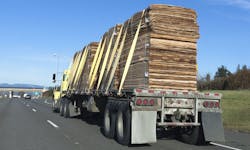Spot rates and volumes are returning to the “old” normal, falling more in line with typical seasonal trends, according to June data from DAT Freight & Analytics. Van, reefer and flatbed rates all increased from May to June.
Overall, the DAT Truckload Volume Index increased by 13.7% in June, 9.4% better than June 2019.
Dry van posted an average of $1.80 per mile across the country, which is 13% higher than May, though down $0.09 from last June. Van load-to-truck ratio, which hit a low in April of 1.0, is now at 3.5. That’s nearly 13% better from June 2019.
The average U.S. reefer spot rate hit $2.15 per mile, a 6% hike, and like van, also $0.09 off last year’s mark. DAT attributed the reefer volume increase of 4.5% to seasonal produce coming from the Southeast, West Cast and Pacific Northwest. Reefer truck-to-load—5.5— tripled the all-time low in April of 1.7 loads per truck.
Flatbed received a boost by a flurry of construction activity. The $2.07 rate was 9% higher than May, but a dime short of June 2019. The June truck-to-load for flatbed of 24.8 was the highest since June 2018. Flatbed volume increased almost 16% from May and was about the same as last June.
“The surge we’re seeing in spot truckload rates and volumes is consistent with summer trends, but consumer habits continue to be impacted by COVID-19,” said Ken Adamo, chief of analytics at DAT. “For instance, there’s been an early increase in demand for pressure-treated lumber as people tackle home improvement projects. But produce growers and distributors are contending with soft restaurant demand as states reopen at different speeds with different rules.”
As COVID-19 has reared its spiky head again, California has gone into a second shutdown and Texas has closed its bars, so that restaurant demand is unlikely to improve in July. The rest of the economy also remains in flux as the nation struggles to contain the coronavirus. Back-to-school (or possibly stay-at-home school) shopping and the influx of single-family home construction should help the dry and flatbed sectors for the rest of the summer, DAT projected.
“There’s clearly pent-up demand in the economy, but the recent surges in COVID-19 cases remain a complicating variable for consumer behavior this summer,” Adamo said. “Retail and consumer packaged goods volumes are way up, but manufactured goods are way down.”
About the Author
John Hitch
Editor
John Hitch is the editor-in-chief of Fleet Maintenance, providing maintenance management and technicians with the the latest information on the tools and strategies to keep their fleets' commercial vehicles moving. He is based out of Cleveland, Ohio, and was previously senior editor for FleetOwner. He previously wrote about manufacturing and advanced technology for IndustryWeek and New Equipment Digest.


